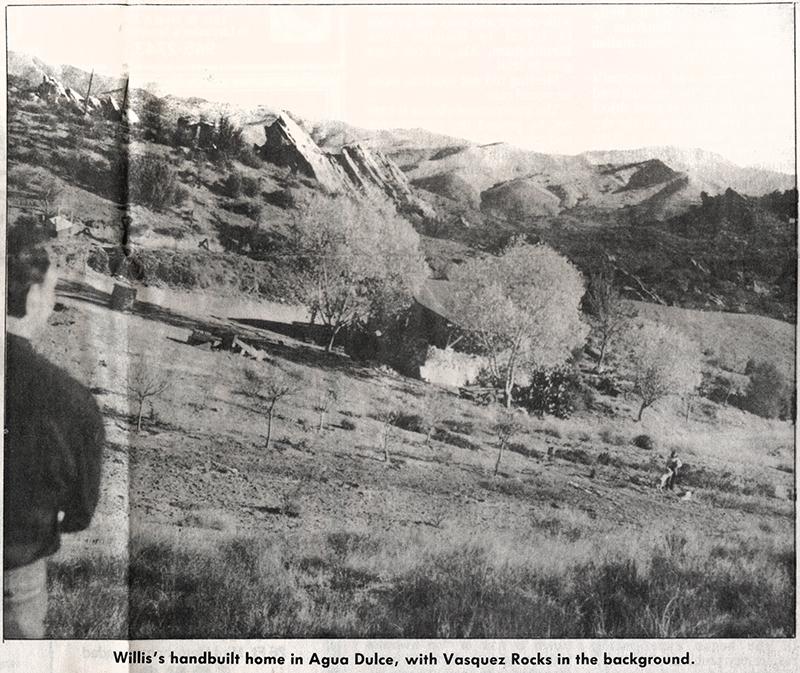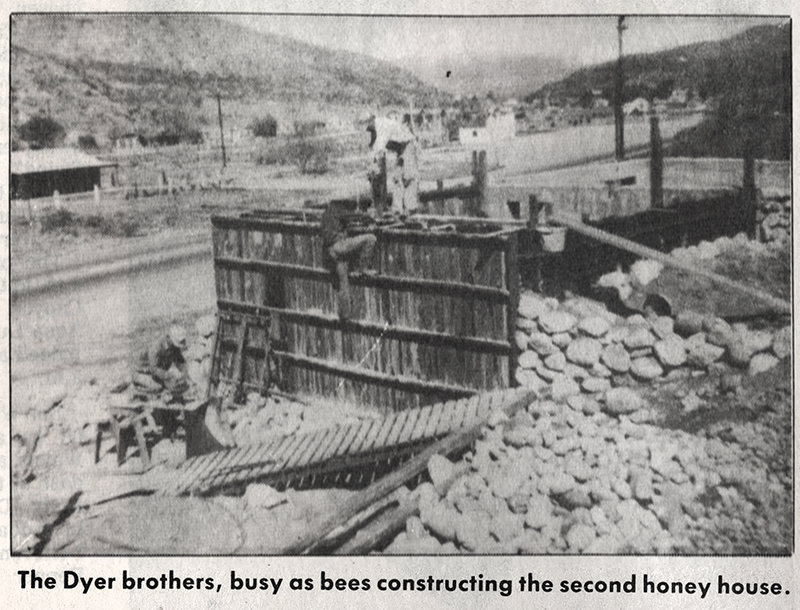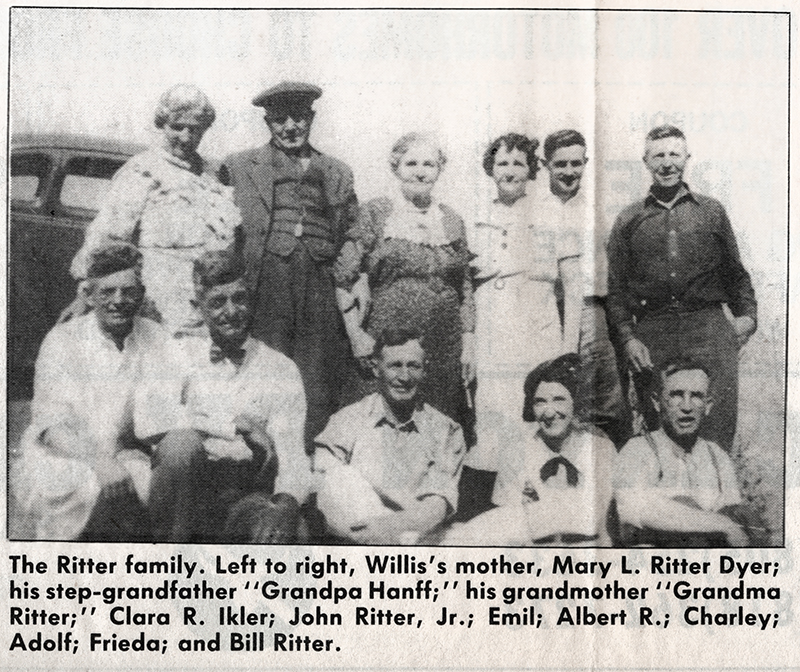|
|

Eyewitness to the 20th Century
Willis Dyer, Agua Dulce Apiarist.
The Newhall Signal and Saugus Enterprise | Friday, September 6, 1985.
|
When the California Aqueduct builders were working in the Santa Clarita Valley, James Dyer had a butcher shop in Saugus, near where the Saugus Cafe stands today. Supplying meat in the old style meant Dyer grew to know the aqueduct workers and their families — his customers — and learned what life was like for the laborers. A few doors down was another service-offering friend to everybody, Joe the Barber. Young James Willis Dyer liked Joe the Barber and used to trail after him from time to time. One time they wanted to get to the other side of the train tracks, but there was a train across their path. Willis followed Joe under a railroad car. Joe was safely out the other side, but Willis was not when the train began to edge forward. Joe helped him out in the nick of time. At that time Saugus was only dirt wagon roads, with a little oil sprinkled on the main streets to keep the dust down. In 1915, when Willis was 5, his father went out of business and moved to the Sierra Pelona Mountains between Agua Dulce and Palmdale. He homesteaded a patch of land on the mountain at a time when the trip from the mountain to town took a full day with a wagon and a team of horses. Three dirt roads ran through the canyons between Saugus and Palmdale. San Francisquito Road went to Hughes Lake, Bouquet Canyon went through Leona Valley, and Soledad went via Acton. "Soledad Canyon Road must have crossed through the wash ten times before Acton. It was just a two-track road that went right through the wash," Willis said. Sierra Highway was called Mint Canyon Road and jogged around a ranch north of the current Solemint Junction, meeting Soledad near today's telephone company building. Willis and his brother Frank used to travel down to Humphrey's Railroad Station (near where the Canyon Country Fire Station is today), stay overnight, and return the next day with supplies. There they would visit the Mitchells, to whom the Dyers were related by marriage. Willis's father's sister, Iva Dyer, had married John Mitchell. The boys would visit back and forth on horseback between the Dyer homestead on Sierra Pelona and the Mitchells' ranch on Soledad wash. Al and Tommy Mitchell were the same ages as Willis and Frank.
In the summer, when the meagerly irrigated homestead was not very productive, James Dyer would haul apricots and peaches and other food from local farmers down to Van Nuys to the cannery. The Dyers grew dry land hay, oats and barley. The homestead did have a spring, the water of which they used to nourish a vegetable garden. James Dyer also kept a few hives of bees, and Willis would help extract the honey. It took three years to "prove up on the homestead," which meant that the federal government gave the land to the family after they had lived on and worked the land for three years. At age 6 Willis started school, riding a horse three miles each way to the Leona School at the corner of Bouquet Canyon and Elizabeth Lake roads. On the way he rode through the Ritter Ranch, where his maternal grandparents lived. His mother had been the oldest of their nine children. The elder Ritters had a vineyard and a winery in which all the children worked, but four or five of the sons formed a partnership and went into real estate. Eventually the Ritter Brothers accumulated 25,000 acres, Willis said, and sold land to subdividers who built a large housing project west of Palmdale. The Ritters kept a number of honeybees on their ranch. Later, when the Ritter Brothers business took off and the Ritters no longer had time to care for their bees, Willis and Frank bought their 700 hives. Grandma Ritter was "a wonderful cook. She made the best German cookies with a bitter taste of almond," Willis said. She kept the family together after Willis' grandfather died, and later remarried. From 1917 to 1919 the Dyers lived in Van Nuys, while James worked trucking, as he had been doing before during the summers. Van Nuys was a tiny town then, made of several stores, bean and tomato fields and orchards. Where the General Motors plant is now there was a dairy farm. A few houses were sprinkled around, but Van Nuys was nothing like the metropolis it is today. One line of the Pacific Electric Red Cars went through the valley at the time, from L.A. through "Lankershim" (now North Hollywood) and on to San Fernando. To travel from San Fernando to Newhall, one road went through a narrow tunnel that was eventually broken open in the 1940's [sic: 1938] into a "cut" with virtually vertical sides. Around 1920 the Dyers sold the homestead and moved to Mint Canyon, just south of where Le Chene restaurant is now on Sierra Highway. Willis went to the Mint Canyon school when it was near where the Halfway House is. From 1921 to 1922 the family moved to the dry lake that is now part of the Edwards Air Force Base, where the space shuttle lands. Willis and his wife Julia Ann (nee Bailey) have been there to see the shuttle land. "The place where they had us park was right near where I lived as a boy," Willis said. Willis experienced both extremes of the isolated rancher life of desert and the transformed area as a hub of the technological avant garde. As for actually seeing the shuttle, he said, television is better. The lenses of the cameras bring people closer to the shuttle than one may actually stand.
When Willis was growing up, the railroad tracks went right through the dry lake. A tiny village sprung up beside the railroad station, called Muroc (the backward spelling of Corum, the name of a rancher up there). Muroc consisted of the railroad station, a grocery store and a handful of houses. The Dyers lived on a cattle ranch a bit east of Muroc. Willis drove himself to school — at the age of 11 — in a hand-cranked Model-T Ford. Sometimes the winds were so strong across the lake that Willis could not drive straight into them. He would have to tack, like a sailboat, zig-zagging back and forth, while the wind seemed to push him farther from his destination. The wind drove sand before it, pitting the windshield like a sandblaster would. Willis remembers when Cecil B. DeMille was filming a scene from "The Ten Commandments" near Muroc in 1922. He transported all his actors, extras, horses and props to the remote site by train. "They had lots of horses and men," Willis said, "Sometimes wheels broke off the chariots and they had an accident. Sometimes the horses would run into each other." The chariots used in the scene were sent back to Universal Studios, where they are now displayed to visitors. But parts of the huge plaster-of-paris sphinx and pyramid used for the Egyptian scene filmed elsewhere were buried in the sand, too bulky to transport back to Hollywood. Willis said that a recent Reader's Digest article said that someone is now trying to uncover the forgotten props. * * * The Dyers moved back to Newhall, and Willis attended San Fernando High School for ninth grade. His parents returned to Mint Canyon the next year, which made the only high school in the area even farther away. So, Willis went to stay with his aunt Bessie Dis in Burbank to attend Burbank High for 10th grade. After that he quit school and moved to Agua Dulce. Willis married Dorothy Tate in 1933 and they had three children — Jim, George and Letty Ann. Near the entrance to Vasquez Rocks, Willis bought a 5-acre plot. He built a house, building the rock foundation and walls himself, he said, as he would later help do the masonry for the Dyer Brothers' honey house. He planted a small orchard and a row of pine trees which are now over 50 feet tall. "That's what happens over time," Willis said with a grin. In 1934 the Vasquez Rocks lot cost $100 an acre. The property now belongs to Willis' brother's sons, and someone recently offered one of them $60,000 for one of the acres. Another drastic economic change which astounds Willis is the price of gasoline. He remembers buying gasoline for 5 cents a gallon. When he took a trip to Iowa in 1938 in a little Willy's car (which he describes as "like a Volkswagen"), the entire drive there cost $14.65. But that was traveling the northern route, where gasoline was relatively expensive. The return trip through the Southwest cost only $12.45. * * *
Around 1941, the Dyer Brothers began to build the honey house in Agua Dulce, which his brother Jim still uses for his 1200-hive business. The government decided that the bee business was essential to the war effort, Willis said, and he was needed to stay at home. Beeswax was used in various industries, including the waxing of skids for launching ships. Frank and Willis worked together for eight years or so, Willis said, until Frank grew discouraged with the bee business and Willis bought him out. Frank went into the grading business. His sons still work Dyer Brothers Bulldozing. Later, Willis' youngest brother, Jim, joined Willis, and they worked as a sort of partnership for a while, too. Willis later bought 40 acres on the Sierra Highway, and in 1952 he started to build the stone and cement block honey house which remains in business (although in different hands), below where he lives now. The bee business has changed quite a bit since Willis was a boy, mostly in the materials and machinery used in the hives and extraction of the honey. When he was young, he hand-cranked a portable extractor in the apiary and dipped the honey knives in hot water to warm them to "uncap" or slice open the cells of the hives. Now beekeepers truck the hives to a central motorized extractor in the honey house and use electric or steam knives to uncap the hives. The "foundation," or sheet formed in a hexagonal relief pattern as the start of the honeycomb, used to be stamped out in beeswax. Now the foundation is made of plastic, and hive frames, which Willis still makes from wood and wire, are available in plastic, too. As for the possible changes in the industry due to the so-called "killer bees," Willis has little fear. The problem has been "exaggerated by the press," Willis said. Although the Africanized bees are a more aggressive variety and "we don't want them here if we can avoid it," they are manageable, Willis said. He said there are beekeepers working with Africanized bees in South America with little difficulty. Any bees swarm somewhat in springtime and will sting if they are disturbed. But with proper manipulation, he said, people can control the swarming. The bees swarm if they don't have enough room, so many problems can be avoided by adding "supers," or extra height to the hives when they are needed. "Bees have to be taken care of to get the most out of them," Willis said. * * *
In 1977 he built himself a new home on the portion he retained of the original 40 acres that he built the second honey house on. This house, too, he built of cement blocks. He always builds with stone and cement, he said, for protection from fire. He points out that many of the ageless buildings in Europe are made of stone. Willis still keeps a few hives, a small centrifugal extractor and equipment for melting the combs down and separating the wax from the honey in the combs. At 75 years of age, he also keeps grapevines and fruit trees, and builds and repairs trucks. He has a shop where does metal work, both for the trucks and for small projects like a metal porch awning and set of stairs for his home. His wife tends a small garden and creates oil paintings in both realistic and surrealistic styles ("That's how my mind works," she said). The couple also travels frequently, and Willis enjoys hunting and fishing. "Her and I have too much ambition," Willis said, but it doesn't seem to hurt either of them. "You have to keep busy," he said. "These people who sit in a rocking chair just get old." This is the sixth and final biographical profile of The Signal's second series of "Eyewitness To The 20th Century."
Download individual pages here. Clipping courtesy of Cynthia Neal-Harris, 2019.
|
SEE ALSO:
Story: 20th Century Vasquez Rocks
Commodore Perry Dyer, Soledad Pioneer (Story)
Brochure ~1930s
1930s Claude Ellis Art x5
Feature: Willis Dyer
James Thomas Dyer
1881-1960
Points of Interest w/ Letty Dyer Foote
Legacy: Dyer Family
"Werewolf of London" 1935
The Ivory-Handled Gun 1935 (Full Movie+)
|
The site owner makes no assertions as to ownership of any original copyrights to digitized images. However, these images are intended for Personal or Research use only. Any other kind of use, including but not limited to commercial or scholarly publication in any medium or format, public exhibition, or use online or in a web site, may be subject to additional restrictions including but not limited to the copyrights held by parties other than the site owner. USERS ARE SOLELY RESPONSIBLE for determining the existence of such rights and for obtaining any permissions and/or paying associated fees necessary for the proposed use.













